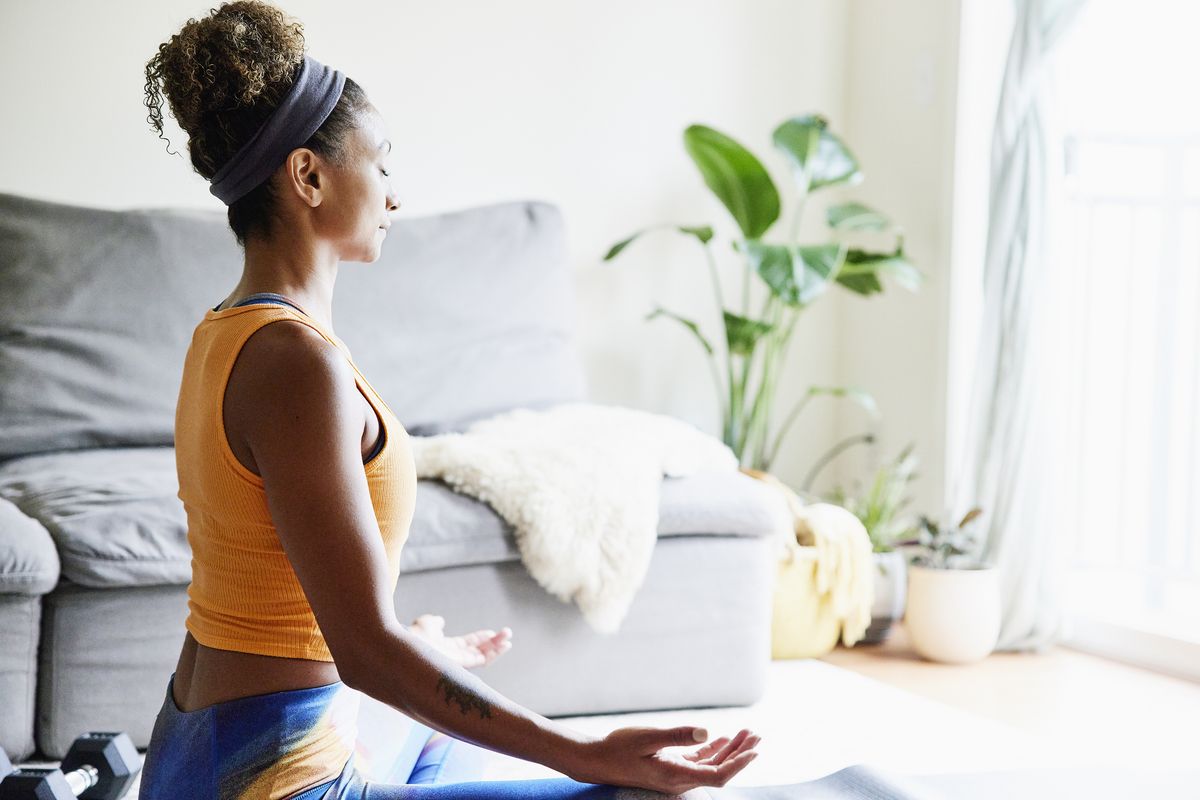If you’re overwhelmed at work, stressed out by the state of the world, or just want to learn how to be more mindful, odds are you’ve thought about incorporating meditation into your lifestyle. It isn't exactly as easy as just sitting down and it'll happen, though. And ICYMI, this practice has a super rich history across a breadth of cultures. It can be a bit intimidating at first, especially if you’ve never actually done it before and don't know how to meditate. Lucky for you, Women's Health is here to help.
Meditation is the practice of focusing on one singular point, says Chelsea Jackson Roberts, PhD, a yoga and meditation instructor at Peloton. This "point" can be drawing your attention to your breath, visualizing, connecting to your innermost thoughts, or making an effort to think of nothing at all. In short, there isn't just one way to pull your attention to the present moment—the key is learning how to meditate in general, and then deciding the best method for your needs.
And no, you don’t necessarily need a teacher. That said, if you’re a true beginner, it can help to have some guidance along the way, explains Justin Michael Williams, a Skillshare meditation teacher and the author of Stay Woke: A Meditation Guide For The Rest of Us. “A teacher in meditation is there to guide you to trust and know yourself,” he says. For example, if you were taking a yoga class for the first time, an instructor would be there to watch your form and ensure you’re not going to hurt yourself. “With meditation, a teacher is somebody who's skilled enough to tell you, ‘Hey, actually, that thing that you're doing might harm you,’” Williams adds.
Now that you’re up to speed on the basics, let's get into the nitty-gritty details. Here's everything you need to know about meditation, its benefits, and the exact steps to do it, according to experts.
What are the benefits of meditation?
Many people turn to meditation to cope with life’s stressors, but there are other benefits too, all of which are backed by a growing body of research. For example, the deep breathing practice often goes along with meditation can help lower your blood pressure—especially if you have hypertension, some studies show. Meditation can also help decrease chronic pain, reduce insomnia, and even help prevent memory loss related to Alzheimer's disease.
From a psychological standpoint, meditation can moderately improve your anxiety levels, research demonstrates. And, if you suffer from depression or PTSD, meditation can help as well.
“When you carve out the space and time to allow your body and mind to rest, you're giving your nervous system an opportunity to recharge,” explains Jackson Roberts. So, if you experience any of the aforementioned issues, you might want to consider adding meditation to your routine.
And honestly you don’t need to meditate for that long to get the positive effects: One study saw lower anxiety levels among participants after just eight weeks.
How long should you meditate for? Experts recommend anywhere from 12 to 20 minutes per day for optimal effects, says Kathrin Werderitsch, a yoga and meditation instructor. That said, if you feel as if you can’t jump right in for 12 minutes, that’s okay—even five minutes can do wonders for your health. (More on that later!)
What are the different types of meditation?
There are literally thousands of ways to meditate, all of which can depend on your religious background, cultural histories, educational experience, and the like, Williams says.
Here's a breakdown of all the variations that have become popular in mainstream culture and how they might suit you. (And FYI: Many of these can be called by different names, depending on who you're talking to.)
- Body scan meditation.“It’s very easy, and it’s just bringing awareness to each different part of your body, then intentionally relaxing it,” Williams says, and it's great for when you are stressed or can’t fall asleep. For example, you’d make a conscious effort to feel your toes, then relax them if they’re clenched or holding onto tension. You work your way up your entire body until you reach the top of your head.
- Visualization meditation. For this technique, you focus on a person or feeling. Then you direct your attention toward that—perhaps setting the intention of generating love or gratitude—and as the meditation progresses, those feelings increase and, ideally, make you feel good, Werderitsch explains.
- Breathing meditation. This typically requires guidance from a teacher or voice prompt through a series of breathwork exercises, Jackson Roberts explains. The spotlight is on how you take air into your lungs and then exhale, with all of your attention focused on your breath. As mentioned, breathing-based meditation can help reduce blood pressure and anxiety.
- Freedom meditation. Williams describes this as a way to “get in touch with your true authentic self.” Freedom meditation tells you to focus on your innermost self, whatever that means to you. This method is great for beginners, according to Williams: There are not as many steadfast rules, per se, so there’s less room to beat yourself up if you feel you aren’t getting it right.
- Mantra meditation. With this, you'll say a few words that you’d like to truly digest, either out loud, at a whisper, or in your head, says Robyn Heather Cohen, a yoga and barre instructor based in California. Some examples include “may I feel peace,” “may I feel gratitude,” and “may I feel calm.” Whatever best suits your mental or emotional needs at the time, Cohen says. If you’re yearning for a feeling and want to make it stick, try giving mantra meditation a shot.
So, how do you start meditating as a beginner?
If you’re doing meditation for the first time, don’t be too hard on yourself or expect everything to go perfectly. Your mind may wander, you may have trouble sitting still, and you might not want to continue for the entirety of your predetermined meditation time, Williams says.
And guess what? This is all totally normal, even for seasoned pros. “Practice kindness throughout this entire process,” Jackson Roberts advises. “Meditation is not the easiest thing to do, otherwise everyone would do it. Use your breath as your anchor.”
The first step is to make an agreement with yourself that you will practice meditation daily. “Mark out a time on your calendar that you are going to meditate, and stick to it,” she says, whether that’s during your lunch break, before bedtime, or first thing in the morning.
Then, start small. Don’t force yourself to do 20 minutes if you’ve never tried it before. “Try to master five minutes, and then increase by small increments,” Cohen suggests. Over time, you can work up to longer periods.
If you’d prefer to receive instruction in a classroom setting, search for studios in your community. If in-person isn’t an option for you, sign up for a virtual class on platforms like Skillshare or look for a free one on YouTube. There are also popular apps like Headspace, Werderitsch says, or you can try Jackson Robert’s meditation sessions on the Peloton website.
What are the steps of meditation?
Know that these are the steps for doing a general meditation from start to finish, according to experts. That said, know that meditation practices can vary. Just because yours might differ slightly from this one does not mean you’re doing it “wrong” or that you need to make changes, if you feel that you’re doing what works for you.
- Determine which practice you’ll do. Ask yourself what kind of energy you want to bring into your day, Williams explains, and let that determine which kind of meditation you’ll choose.
- Find a comfortable position. You can be seated or lying down, whichever you like. “If your body isn’t comfortable, your brain can’t relax,” Williams explains. So, figure out what your “Netflix-level comfortable” position is and move on from there, he says.
- Set a timer. Whether it’s on your phone or with a manual timer, set a fixed duration for which you’ll meditate so that you will be gently notified when it’s time to stop. (Make sure you do this before starting. Williams points out that you don’t want to be near your phone when you meditate.)
- Close or gently rest your eyes. If you close your eyes, shut them lightly as if you are dozing off to a nap, Williams says. You don’t need to scrunch your eyes and apply pressure in your face. In fact, this part can be optional. “I like people to know that you do not need to have your eyes closed,” Williams explains, because for some this can be distracting. If this describes you, set your gaze upon the floor.
- Breathe, slowly and deeply. Williams recommends starting out with a three-count breath. This means that you will inhale for three seconds, hold your breath for three seconds, and then exhale for three seconds. Try repeating this process until your meditation is over, focusing on the breath, Williams says. When you get distracted, bring yourself back to the breath.
- Rest for a minute, once your meditation is over: If you need to get going with your day, that’s okay. Just give yourself a minute to be away from your technology, to relish in the meditative practice and sense of calm you just manifested, Cohen says.
What if you just can’t do it?
That’s understandable! Meditation can be difficult, but don’t give up. “The number-one thing I hear in every language, all over the world, is people think they ‘can't meditate,’” Williams says. “They can't get their mind to stop thinking. And what I tell people is: Nobody can get their mind to stop thinking." The trick is to get your thoughts to work for you instead of against you—to direct your awareness to what you want to, rather than letting your mind run wild.
If you can worry, you can meditate, Williams says. “Worrying and meditation function almost the same way. When you worry, you come back to some negative thought pattern that you're centering your mind around again, and again, and again," he adds. Meditation is the same practice, except you are replacing worrisome thoughts with empowering, compassionate ones.
If you feel like you don’t have room in your life to fit it in, try reevaluating your schedule. Be deliberate about blocking out your calendar for yourself, says Jackson Roberts—even if it’s just five minutes.
Are you falling asleep when you meditate? That could mean you’re just… tired. In this case, your meditation is signaling to you that you’re not rested enough, and you should listen to your body and try to get the sleep you need.
Overall, remember this if you get discouraged: Meditation is not just something that you do for yourself, but rather, for everyone around you too, Williams says. You are making a conscious effort to take care of yourself so that, in turn, you can put forth your newfound positive energy back into the world.













